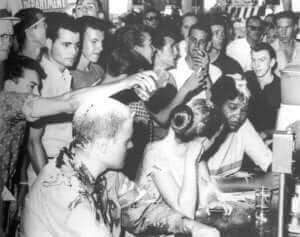This week we commemorate Dr. Martin Luther King Jr. and the 50th anniversary of his assassination. With my students I’ve been exploring the ways in which the same skills we practice in mindfulness were part of the philosophy of nonviolence, crucial for the civil rights protests in the 1950s and 60s.

Modeling Nonviolence
Dr. King’s 1958 Stride Toward Freedom articulated this philosophy in Six Principles of Nonviolence. The premise that “nonviolence accepts suffering without retaliation” translated into effective protest. The student protesters who organized the lunch counter sit ins across the south learned to remain silent and still in the face of physical and verbal assaults. They practiced ahead of time, through workshops how not to respond with violence, which is our body’s very natural and “hard-wired” first response. Such preparation is depicted well in the PBS’s 1987 documentary Eyes on the Prize (language warning), as well as a scene in Hollywood’s recent The Butler (Lee Daniels, 2012).
Teaching Body Awareness
One of the key skills we teach in mindfulness is body awareness. Students learn to recognize different sensations in their body, and how these connect to their emotions.
In discussing King’s philosophy of nonviolence, I ask students to imagine or share with a neighbor a time when they felt angry at someone or wanted to get revenge on someone.* I then ask them to turn inward and try to notice or remember what that felt like in their body – to feel physically called to action by their anger – since the body’s very natural response to threat is to mobilize its resources and prepare to fight back.
This provides a visceral way into the conversation about civil rights protests, not just an intellectual one, and it also provides a direct application of the philosophy of nonviolence to their own lives.
Practicing Peace
When we practice mindfulness, we are literally practicing peace – not because our experience in meditation is always peaceful (far from it!) – but because we learn to respond peacefully to our experience even when it is difficult. Stories of 3-year-olds who learn to self-soothe in the midst of a temper tantrums with mindful breathing or high school students who head to their school’s mindfulness room for a body scan rather than blow up at their teacher or classmate show us that when we practice these skills with youth, we prepare them to engage with others nonviolently. At a larger level, we also prepare them to seek positive change in the world around them and to meet the injustices they see in their world (or at a smaller level, the unkindness they see) in a way that is most productive.
* Note: language about “a time when you felt threatened by someone” may be appropriate with some students, but is not advisable where there is a history of exposure to violence or trauma. “A time when you wanted revenge” or “to get even” may be a safer prompt for discussion.
Alan Brown is Director of Integrative Learning at Grace Church School in Manhattan and consults with schools through Learning to Thrive. He serves on the faculty of our Year-Long Certification Program.
